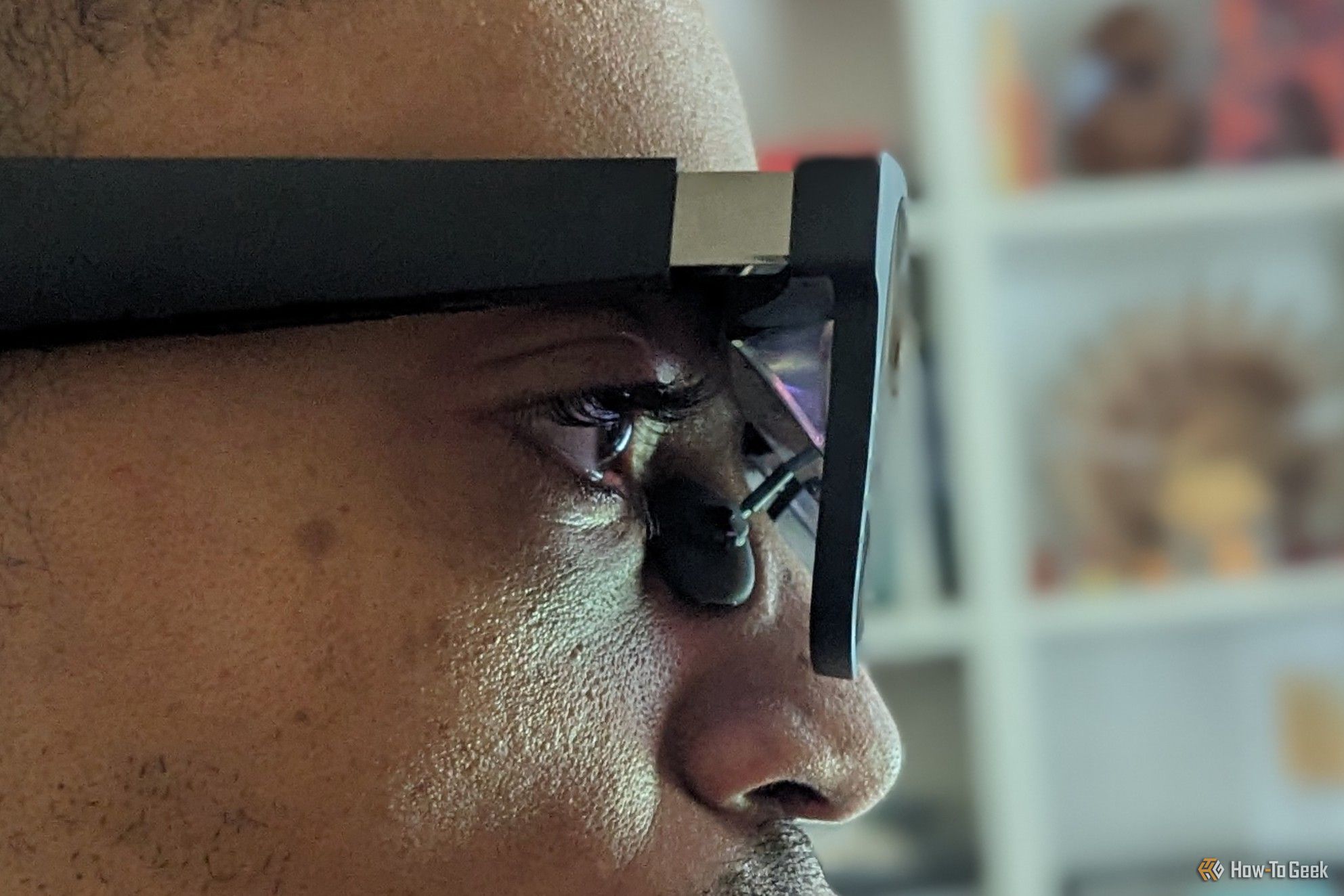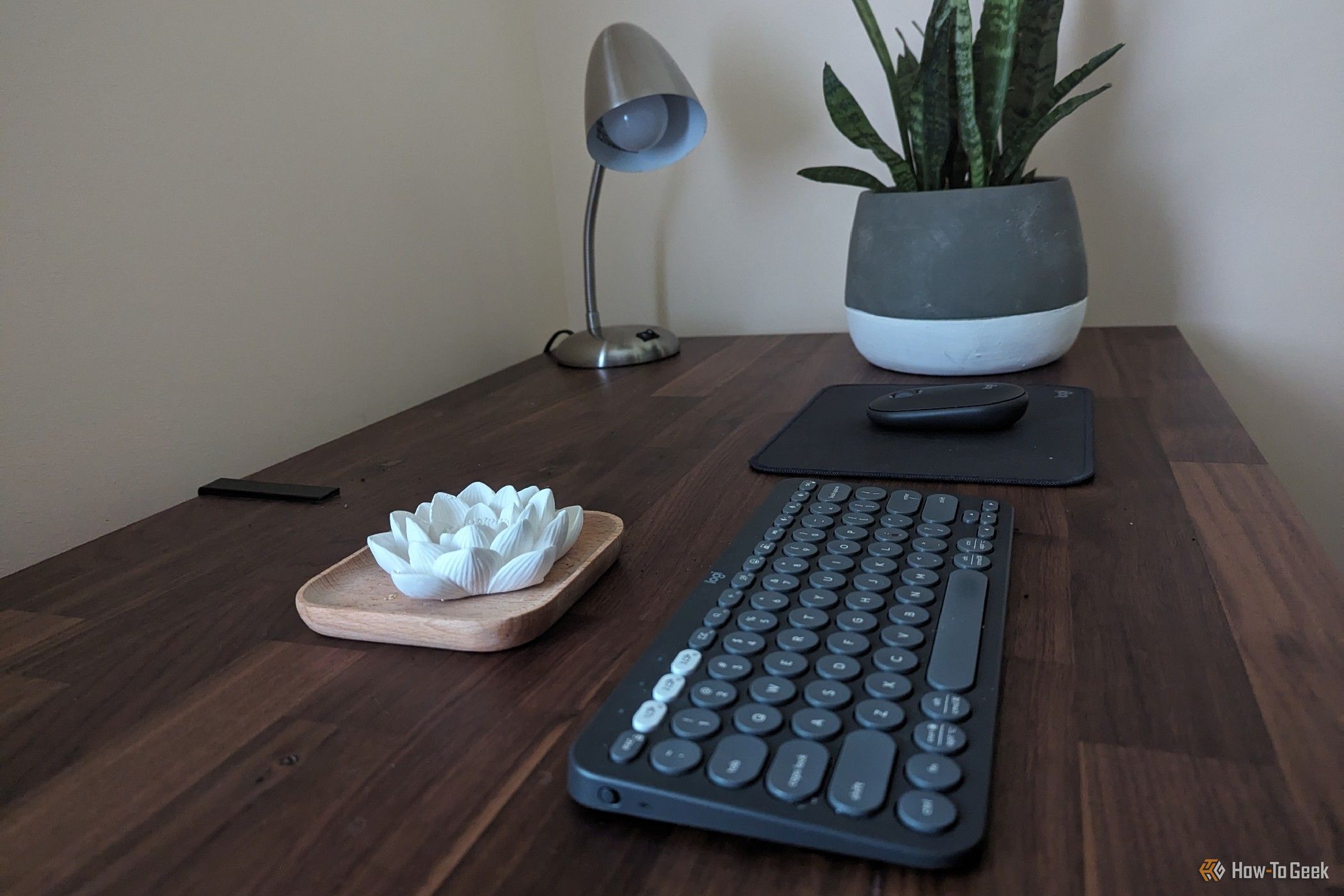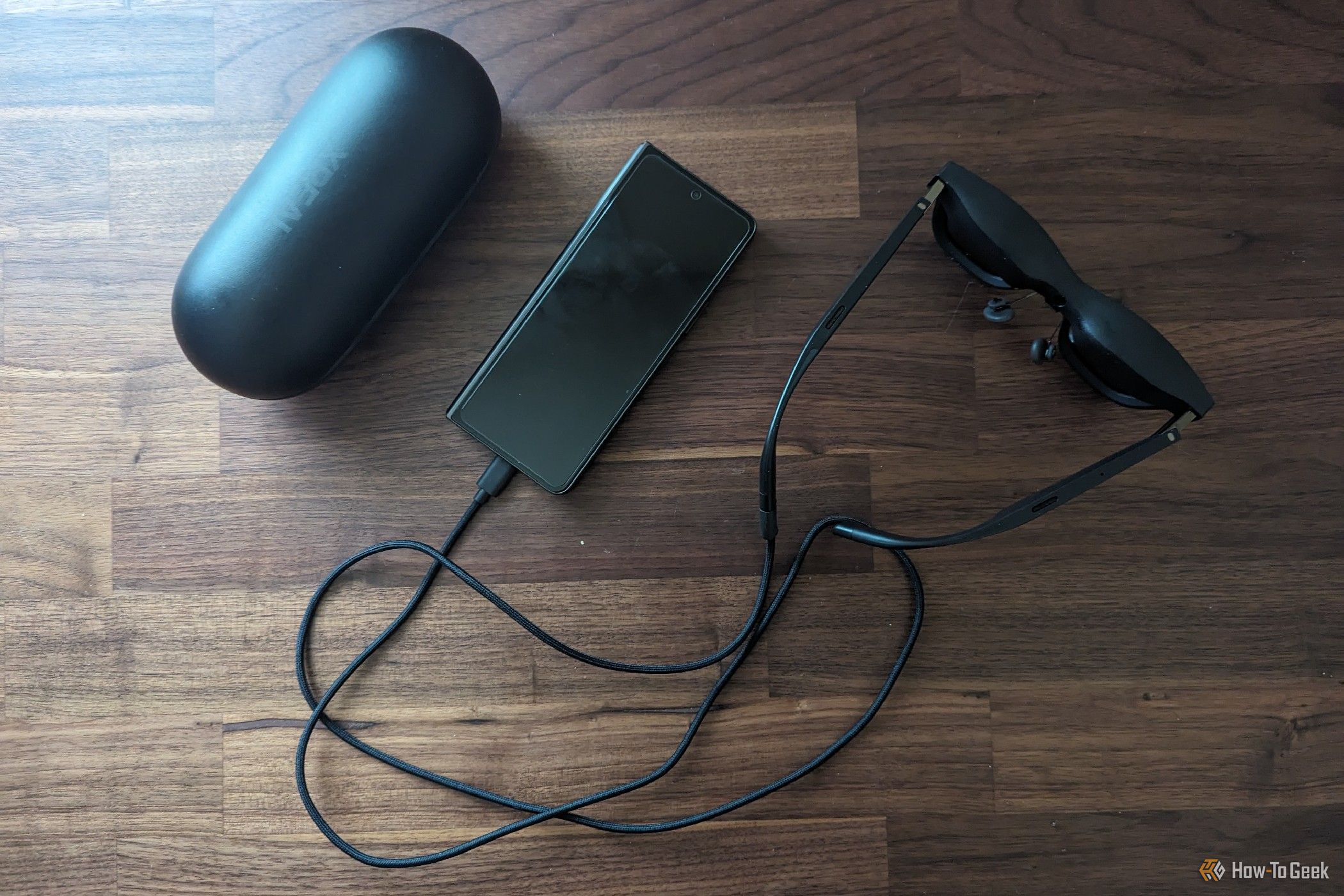
From Screen to Sight: Embracing the Future with AR Glasses - A Personal Tale of Upgrade and Adaptation

From Screen to Sight: Embracing the Future with AR Glasses - A Personal Tale of Upgrade and Adaptation
Key Takeaways
- No more strain than looking at a monitor.
- The glasses encourage good posture and reduce neck strain.
- Boosts productivity with a spacious desk, encourages a better work environment.
I have what could politely be called an unconventional work setup. Instead of a PC, I use Samsung DeX. I do much of my work from the inside screen on my Samsung Galaxy Z Fold 5, and I connect to a larger screen when I need more space. When I saw the XReal Air 2 Pro glasses work seamlessly with DeX, I figured I was the ideal candidate to give it a try. So I bought a pair, and here’s what I’ve experienced.
My Eyes Adjusted Quicker Than I Expected
The XReal Air 2 Pro glasses, like other AR glasses and VR headsets, work by placing two tiny screens right before your eyes. The pro model is largely the same as the XREAL Air 2 , except with the ability to adjust the transparency of the lenses. I was apprehensive about how much strain either model would put on my eyes during a full day’s work. I did feel some strain on the first day, but my eyes were already acclimated by day two. In general, I don’t feel any more strain than I do from staring at a regular computer monitor for hours at a time.
Like a monitor, the glasses let you adjust brightness and color temperature. Unlike a monitor, the most important bit is securing the position on your face. You need the glasses close enough to your eyes, resting on the right part of your nose, at the right height, in order for text to be clear and not to blur at the edges. It took some adjusting, but it felt second nature by the second day.

Bertel King / How-To Geek
I Sit With Better Posture
The biggest impact has been the benefit to my posture. I’ve spent most of my career hunched over a laptop. I ended my days feeling drained, not aware that the angle of my neck had as much to do with that as the strain on my eyes. I was making one of the posture mistakes you want to avoid when sitting at a desk. If you work from home, it’s worth getting a computer monitor with a height set at eye level.
With AR glasses, my display is always at eye level. This means I can rest my neck in a natural position. I can also stretch or look side to side without actually turning away from whatever I’m reading. This allows me to move a bit more throughout the day without shifting my focus away from what I’m working on.
My Desk Has More Space
I like a clear, open desk. This has been one of the reasons I’ve avoided getting a monitor. A monitor, keyboard, and mouse don’t leave much room on my desk for pulling out a notepad or plopping down my phone to work with the stylus.
Wearing the glasses, I generally just leave out a Bluetooth keyboard and mouse. I can also experiment with what else I keep on my desk. I can place a houseplant directly behind the keyboard, since that has no impact on my ability to see what I’m working on. I can place an essential oil diffuser there for the smells. This creates a space that feels more calming as I go about work.

Bertel King / How-To Geek
I Love the Portability
I was quick to embrace netbooks. I’ve experimented several times with using a tablet as a laptop replacement. I once carried around a Toshiba Thrive running Android Honeycomb because it had a full-size USB port for flash drives and an SD card slot for getting photos off my camera.
Lately, I’ve been at it again, using a foldable as my laptop replacement . The screen may be smaller, but the software is more mature and capable. In place of pulling out a computer when Android’s mobile interface isn’t cutting it, I can just turn on Samsung DeX instead . Yet, carrying around a lapdock doesn’t actually take up any less space than a laptop. AR glasses do.
The XREAL Air 2 Pro glasses come with a case that, while larger than your typical glasses case, can still fit in a purse or other small everyday carry bags. To watch videos, I only need to grab my glasses when I go somewhere.

Bertel King / How-To Geek
To play games, I also grab a controller. For work, I also pack a keyboard and mouse. None of these things are particularly big. The keyboard is the only one I don’t bring with me when packing up a laptop.
Awkward Social Interactions
There’s something intuitively weird about looking at someone wearing glasses who’s just sitting there, staring at the wall or gazing up at the ceiling. It’s obvious when someone is watching a movie on a computer monitor. No one has any idea what’s going on in my glasses, unless they hear the sound coming through the speakers or get close enough to my face to see light from the tiny displays.
Wearing AR glasses is a bit like making a switch from Bluetooth speakers to Bluetooth earbuds. The former tunes people in to what you’re listening to, while the latter is completely private. The thing is, while we’ve had decades to get used to this with audio, it’s pretty new for video. When I’m alone, AR glasses are awesome, but I feel weird when I’m wearing them around others.
Great for Working Around Kids
Little kids are in some ways an exception. They don’t really know what’s normal. They’re learning that from us. When I tell them my glasses have screens, and I’m watching a video, they kind of shrug that off. They find that easier to understand than the fact that the video on their tablet comes from something called the internet which stops working if the Wi-Fi is down. I invite you to try to explain buffering to a kid (and if they buy it, please tell me how you did it!).
My kids are still learning that when I’m in the home office, I’m working, and that means they really shouldn’t barge in and ask me questions. Often enough, they come through the door every few minutes, causing me to look away from what I’m doing. Someone’s often crying and needs a hug.
With the glasses on, I can look at my toddler while she rambles and give her a hug. I can keep my eyes focused on whatever Slack conversation I was in the middle of following or continue watching the clip that I was considering inserting into an article. It feels wrong, not giving them my undivided attention. At the same time, I need to work and they’re not letting me. The fact that the glasses help me turn toward them more quickly probably makes them feel like I’m giving them more attention, even if my attention is split. Is that better or worse? I don’t know, but at least they get the hug.
Your Own Portable, Private Home Theater
Watching videos is one of the best uses for AR glasses. I can be sitting at the kitchen table eating my lunch while watching a video that takes up most of my field of view. I can lie down in bed and watch a film that takes up half of the ceiling. I’m not contorting my neck into whichever awkward position helps me see the phone or laptop screen.
The biggest downside is that AR glasses are a solitary experience. I wish my wife and I could watch a movie on the ceiling together. After all, I rarely watch movies alone.
Playing video games is arguably even better. Games that don’t play nice with my foldable’s aspect ratio look just fine on the standard 16:9 ratio of the glasses. With just a game controller, I can feel like I’m sitting in front of a console wherever I am.
All Isn’t Perfect
These are glasses, not goggles, which means I can see around the lenses at all times. While I can block out some of my peripheral vision using the included clasp-on cover, it’s never one hundred percent. That’s why the experience feels more like a portable home theater rather than working in a virtual environment .
Charging is also occasionally an issue. The glasses draw power from my phone, and I need to disconnect them when it’s time to recharge. XREAL sells an XREAL Hub for this, but I haven’t bought one. Unfortunately, none of the various USB-C dongles and docks I already own work with the Air 2 Pro glasses. XREAL’s hub is probably an investment I will eventually make.
To replace a computer monitor with AR glasses, you have to have a taste for the unconventional. Unlike my past experiments with tablets, AR glasses don’t introduce a big change to my workflow. I’m still using Samsung DeX on the same screen resolution I would use on a monitor. I haven’t actually gained any additional screen space, nor have I given any up. These glasses have been a wildly different way to do the same thing, and it’s one I can recommend.
Also read:
- [New] Boosting Revenue with YouTube Short Videos – A Complete Plan
- [Updated] In 2024, Beyond the Mic Advanced Strategies for Professional Voice-Over Work
- [Updated] Mastering Telegram A Step-By-Step Walkthrough
- 2024 Approved 7 Top Budget-Friendly Digital Camera Editing Tools
- 2024 Approved Audience Viewing Experience How to Choose Video Aspect Ratio
- 5 Easy Ways to Keep an Eye on Your Online Bandwidth Spending
- Friend Battles and Buddy Adventures: Essential Techniques for a Shared Journey in Pokémon GO
- How to Resolve Windows 10 Developer Release Installer Hanging During Installation: Solutions Revealed
- In 2024, Mastery in Voice Change with MorphVOX
- Learning the Art of Soundshaping in Audacity for 2024
- Mastering PC Troubleshooting: How to Fix Windows Update Setup Failures
- Revive Your Fortnite Game Chat: Ultimate Guide to Fixing Microphone Problems
- Star Trek Movie Marathon: The Ultimate Order to Experience Them All
- Top 11 Free Online Platforms for Movie Downloads
- Twitch and Two-Factor Authentication: Secure Your Account Today!
- Ultimate Tutorial on Building a Homemade Projector Screen
- Unveiling the Contrast: What Sets the iPad Pro Apart From MacBook Air?
- Title: From Screen to Sight: Embracing the Future with AR Glasses - A Personal Tale of Upgrade and Adaptation
- Author: Stephen
- Created at : 2024-12-04 18:48:35
- Updated at : 2024-12-10 21:06:38
- Link: https://tech-recovery.techidaily.com/from-screen-to-sight-embracing-the-future-with-ar-glasses-a-personal-tale-of-upgrade-and-adaptation/
- License: This work is licensed under CC BY-NC-SA 4.0.